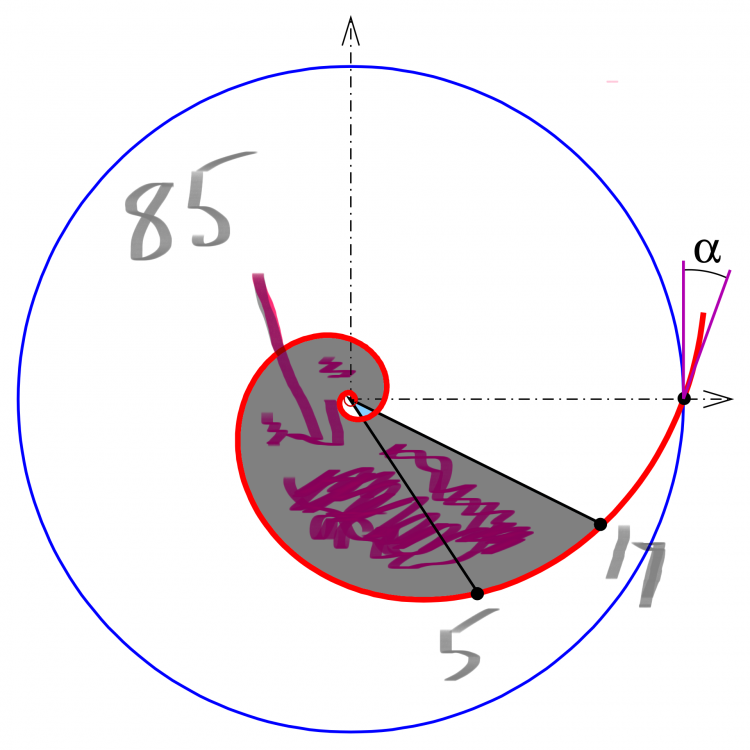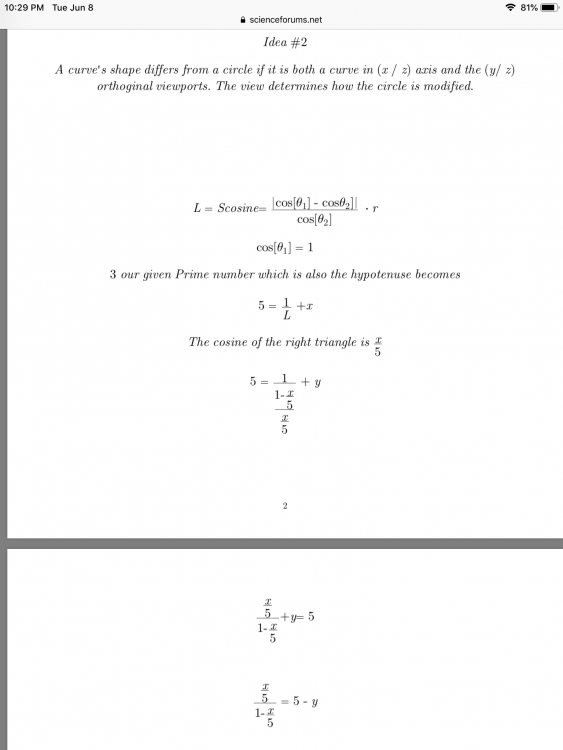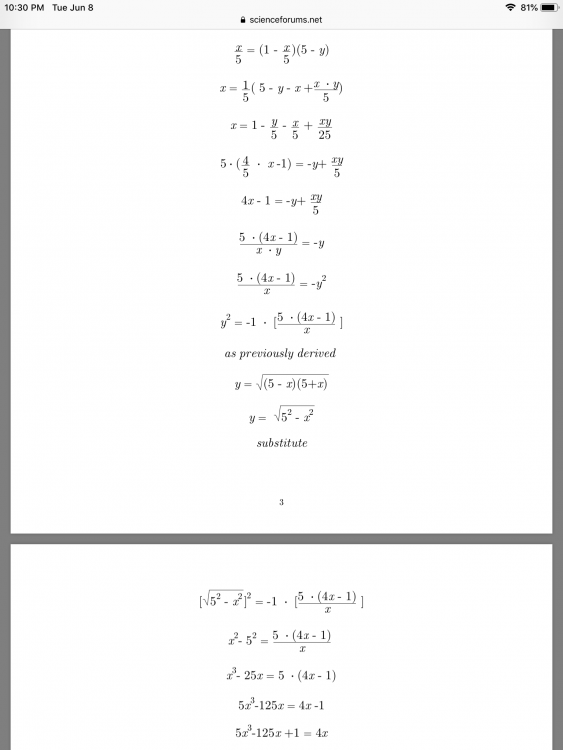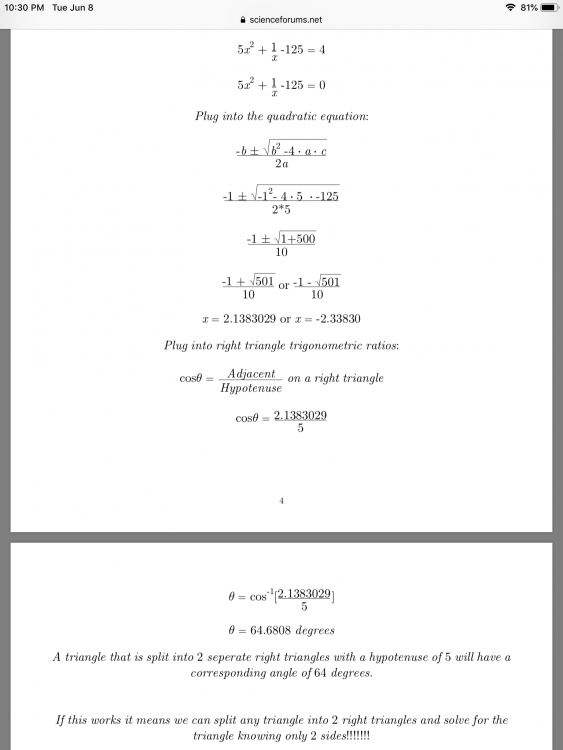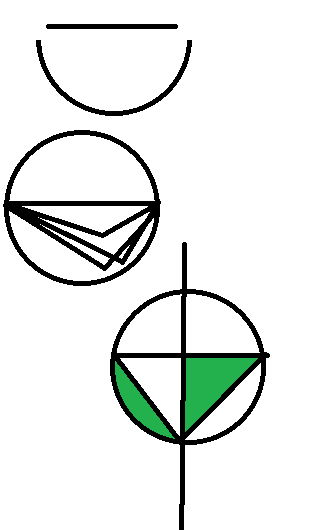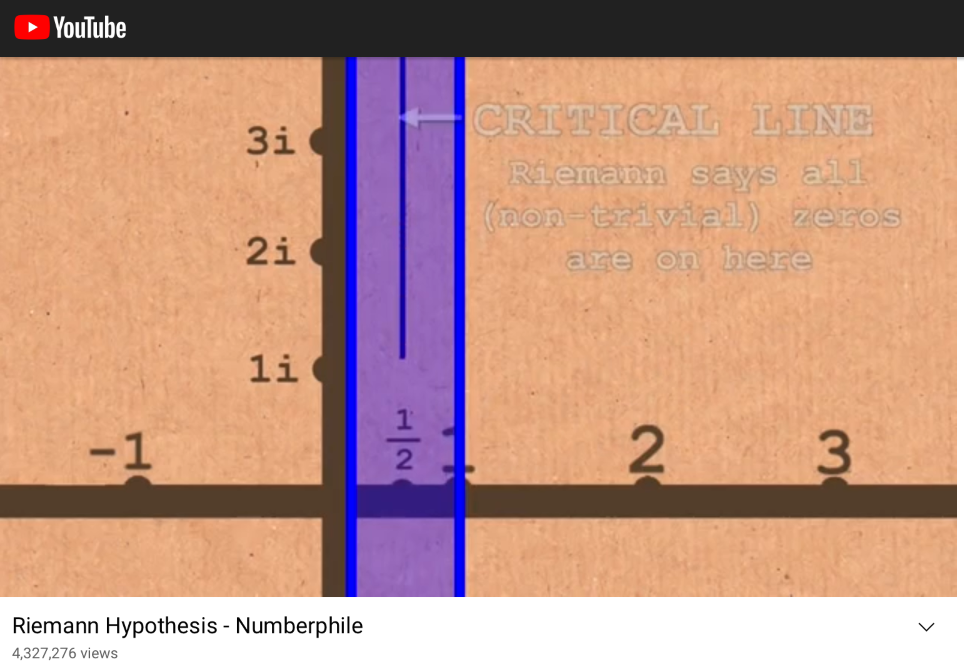-
Posts
421 -
Joined
-
Last visited
-
Days Won
1
Content Type
Profiles
Forums
Events
Everything posted by Trurl
-
Just for you Ghideon I simplified the equation to prove you do understand it. It has been said if you can’t explain it simply you don’t understand it. Remember there is no guarantee it works, but it is simple enough to test. x^3 = [(x^2 * pnp^2) / (pnp^2 + x)] try pnp=85 and an x of 5 Then test more values. Again it may not work but you have followed my thread and challenged me to simplify and prove my hypothesis.
-
“Remember I am claiming I can factor semi-Primes and thus RSA cryptography would be no more.” This comment is to create interest. It is why we are finding semiprime factors in the first place. If I could factor semiprimes with the Pappy Craylar method it would break RSA cryptography. RSA is the first public key crypto. There is no longer prizes for cracking it hence the Pappy Craylar method is shared here. “Yes. And my understanding of the is that you try the opposite; predicting the person from too few polygons. Crude example: There is a pattern, all my models has one polygon. But that is not enough to find the unknown person below.” I should clarify that I am not finding the persons volume, I am referring to the person’s shape, the actual drawing. “I would like some explanation of, or reference to, the mathematical principles that you believe could predict the factors of a large semi prime when the factors are random.” x = Sqrt[ [ ((x^2 * pnp^4 + 2 * pnp^2 * x^5) + x^8) / pnp^4]] x - Sqrt[ [ ((x^2 * pnp^4 + 2 * pnp^2 * x^5) + x^8) / pnp^4]] = 0 Graph for x=0 to pnp; where y = 0 is your x, where x > 0 There are no tricks. I welcome the questions. I think I have something. But you never know with math. BTW if you can solve for x=0 without plotting it, it’s groundbreaking. And the graph of what you just plotted shows a pattern.
-
“I know where you claim the pattern to be. I want to know how there could be a pattern.” How could there not be a pattern? How is there a pattern in DNA with billions of proteins? It is just a model to better understand relationships. Do patterns exist or do you create them? Graphing the equation for possible x’s for given semi prime should show a pattern of x. A scatter plot may or may not show a pattern. But most things that are described by equations is a first step in finding patterns, especially when they are graphed. The graph of the logarithmic spiral is separate from the 4 equations. It is in polar coordinates. The logarithmic spiral could fail if the areas did not fit logarithmically with different Prime factors. But if you graphed the same Prime number with all possible Prime numbers a pattern may result:3*3 3*5 3*7 3*11 The reason I believe there is a pattern is from the log spiral model. Most attempts to find patterns in Primes is solving series. I used geometry and equations. I was a graphic artist. They teach that when you draw something it helps to break the scene into basic shapes. Obviously the world is chaotic but if you were to 3D model a person you would break them into polygons. And yes, I believe there are patterns in everything. If there weren’t we would not have mathematicians.
-
Sorry for the delay. I was on a trip. Well my goal is to convince you a pattern exists. The scatter plot does not show a pattern, but that is true of many patterns. Although some one YouTube did show that Prime numbers in the coordinate plane fits a logarithmic spiral. It is different from my work but I say the 4 equations show the pattern. If you graph the equation for one Prime number and a domain of possibly x values, it is an inverted normal distribution. The pattern is in the equations. Without that pattern we have no pattern. So if you do not see a pattern in the equations there is no pattern. The log spiral is separate from the equations. It uses areas. I am working on the drawing. No guarantee it will work, but I just want to show my logic.
-
There is a chance my spiral may “break the rules” of a log spiral. If so it doesn’t matter it would just be a custom spiral. I need to draw it. From here on out I will call this project the Pappy Craylar Conjecture.
-
Yes a semi-Prime based on two random Primes. I refer you to the four equations already in this thread. Plug and chug. I know plug and chug is referred to as improper math, but here we are just testing values. I know I can’t yet find x perfectly. But the equations show the pattern between the semi-Prime and the smaller factor x. I know you are think so what if we know PNP and x we know y. Point taken. But you can test for x by graphing the equation. Which I am arguing is faster then recursive division. The pattern I am trying to draw on the log spiral is from the four equations. The equations do not hold true for non-semi-Primes. So I figure if I can come up with a geometric model of the equations a pattern may result in the model. I need to draw the log spiral, I know. My hypothesis was that if I could relate the area of the sector to the semi-Prime at arc lengths of the Prime products a pattern would result. That is because the equations are only true for Prime products. I know, I should draw the log spiral and prove it. But to do so is very labor intensive, so I though I get feedback on the forum. The link WTF posted had beautiful graphics but it was just a sieve. I don’t know how to program my log spiral. It should be possible but it is very complex. Hopes this helps explain my reasoning. Plug and chug the equations. That should show the pattern in factors. A pattern unique to semi-Primes. It really isn’t a pattern of Primes put a pattern in factoring. Like in science where you can’t find answers directly, instead you use what’s known and find the pattern indirectly.
-
Awesome link. I wonder what they used to create the graphics. That is different from my attempts. They just have a sieve. I am trying to find a log spiral where the area equals the Prime products. The area should not equal with numbers that aren’t Prime. The parabola I created isn’t a sieve. That is why I asked you to look at the worked example. I tried to write a mathematical proof. I enjoyed the link. I have never seen other people relating Primes to parabolas. It seems like just a sieve and it is very complex. I know my looks complex like any factors will work with any number but it should only work with Prime products.
-
Clarity and argument are good. I post to solve problems and have good discussion. I envisioned the log spiral to increase in magnitude. The magnitude being the arc of Prime factors, 5 and 17. I propose as the magnitude increases so does the log spiral and it’s sector. That is given. But what if we graph 3*5 then graph 5*7 then 7*11 then 11*13? Will we find relations between their angles and areas of the sector. I don’t know of any attempts to do this.But other the circular functions and a spiral I don’t know where this idea could be tested geometrically If you took 3*5 then 3*7 then 3*11 ... then 3*5 then 5*7 then 5*11... and graphed them on a log spiral at the very least it would organize the Primes. But what if you tried a number that wasn’t a Semi-Prime would the area match the product of the 2 products that form the radius? Does the log spiral formed by 5*17=85 fit all Semi-Primes? Can we mathematically change the spiral so that we can test manipulations like a sine curve for alternating current? Can we find patterns in factors only seen in Semi-Primes: (x^3/N) approximately= (x^2/y) Here you could invert the fractions and see if the area between x and y, N is divisible by x^3 as y is divisible by x^2 There are other tests such as: (25/17) approximately= (85/58) That is my argument of the log spirals usefulness.
-
Well that is completely unscientific. You did not prove it wrong. You took one value and came to the conclusion it has nothing to do with Semi-Primes even though you just took 2 factors and related the sector area to the Semi-Prime. So simple that it seems insignificant. But the hypothesis exists to disprove. You have to creat an algorithm to graph all known Semi-Primes or at least enough to sample the data. If you believe that any of the 4 equations I posted show any pattern in the factoring of Semi-Primes, why would you think this geometric model would not have any truth?
-
A=r(φ2)2−r(φ1)2 /4K But you didn’t use the area equation right. Radius * angle squared - radius * angle squared divided by 4K
-
The parable work was posted June 9th. I propose there will be a pattern once we do this process with all possible SemiPrimes. If no pattern we can still manipulate the semiPrimes as we would a log spiral.
-
I mean from the origin to a radius of 17 the angle between is 62 degrees. How did you square 17 and 5 without taking into account the angle between each. I think you missed a variable The angle is the unknown. My answer may be wrong. I will write it up when I get a chance. But I also think you forgot the angles in the area equation. No, it ties in differently. I want you to also comment on that worked example but we are on log spiral now.
-
I got an angle between zero and 17 of 62.14599 degrees. Is that what you got? BTW, what are the errors of the 2sided triangle worked example I posted in the pictures. I wrote it 12 years ago. If it can be corrected, it would be useful. You should note it is inside a parabola. It is probably flawed but my description seems like a worthy effort. I just gave you the angle now because I don’t have time to write out my work now.
-
No, it is untested as I said. I was just showing the example I was describing. I think it should be solved by the equation of area of sector. Else it is difficult to draw. I was looking to draw it in AutoCAD 14 or FreeCad. But if it is done by equations first it would be possible to draw relatively easy. Remember it only my hypothesis. But it is also the model I based all my work on. The process is simple: relate the math work to geometry. But starting a pattern in the geometry is challenging. I believe if we can make the geometry represent the equation, patterns will result. Patterns that couldn’t be found looking at the equation alone. Do you have any drawing software to recommend? Also incase you didn’t know I am developing my hypothesis in real time. I have done that since I started working on it. The 4 equations I posted have been developed for some time, but the hypothesis are being done in real time.
-
I still need to test using equation, but a log spiral with a radius from 5 to 17 and a sector area of 85. Just have to plug and chug into equation to be sure an area of 85 can be reached Excuse the graphic. It is rugged but shows what I mean. I am a trained graphic artist but I face compatibility issues since most programs are subscription based. I have to change the way I design and what tools I use. If this works I will draw a triangle.
-
Back to the discussion. I concede using triangles to relate factors to products is challenging. This is the best I could come up with: For semi-Primes and their product where 5 * 17 = 85 a logarithmic spiral with radius 5 and 17 with the angle between 5 and 17 equal to the angle where the area of the logarithmic spiral encompasses an area of 85. You just design the spiral using the known 5, 17, and 85. Do you see any advantage to doing this? I am working on a worked example. The reasons I think it is useful is that it is simple, includes all 3 values, is reproducible, and properties of log spirals are already known. I envision a logarithmic spiral that has semi-Primes positioned along similar angles that occur at different magnitudes. That is similar angles reaching to different lengths of the logarithmic spiral.
-
I Ok. You wanted a worked example. This is for “crafting” a triangle. There is a high probability it doesn’t work. But I wrote it in 2009 and am trying to relearn my reasoning. This isn’t the “vector factors” I talked about. But it is a geometric representation of algebra. It is what is in the pdf I posted but you probably haven’t seen it. It is based in a parabola. I just want to know if it works. No one has ever tested it. I know it might appear absurd but I was inspired when I wrote it. I will address the current discussion in a future post. It is difficult to relate vectors to factors. But I still think it be useful to create such a model. Refer to the images for crafting triangles.
-
I am working on a example. You are right the idea may be too abstract to be useful. I was asking you guys if there was some relation to relate geometry to factors. I believe it may be possible. It doesn't have to be overly complex. I read once that we use the coordinate plane as our main reference for a coordinate system, but we forget anything geometric can create a simple, custom coordinate system. I want to make vectors relate to factors. I know that 5 * 17 = 85 would need an angle greater than 180. But what if the magnitudes of the 5 and 17 results in the same angles as 3 and 13 only the magnitudes are different. What if you had a vector of 5 and a vector 17 and the cross product equaled 85? That is why I tried to use a logarithmic spiral as a coordinate system and have the angles equal and the magnitudes increase. None of this is figured out. That is why I posted the hypothesis. But I do need a concrete example. I am just asking if anyone has any thoughts on a custom coordinate system or vectors related to factors. Or any geometry explaining factors. Yes I know I need to know 3 sides to determine a triangle. But in pnp=x*y you take one known and factor it getting 2 unknowns. Well actually we are using trial and error. But if you could solve any one of the 4 equations, you have 2 unknowns from 1 known. The reason for the geometry is to find a pattern. You are correct in that I don't know this pattern. But that is why I posted. Studiot knew what I was trying to do (to relate geometry), but I have a feeling he thinks it is not possible. That could be. But I will post again if I figure any system that incorporates factors
-
All my hypotheses in this thread rely on these 4 equations being true. p3 = ((pnp^2 + x^3) / pnp) – ((pnp + (x^2 / (pnp^2 + x)) * pnp)) p5 = (pnp^2 + x^3) / pnp - (x^3 / pnp) Separate equations. pnp=x*y x&y are Prime factors of semi-Prime pnp Don’t simplify, graph in software. x = Sqrt[ [ ((x^2 * pnp^4 + 2 * pnp^2 * x^5) + x^8) / pnp^4]] [pnp^4 = [[ ( (pnp^4 * x^2 + 2 * pnp^2 * x^5) )] / x^2 ] – [(x^3 / pnp / 2)] 2 separate equations. pnp = x*y pnp is the known semi-Prime and x and y are the Prime factors. Can plug in pnp and x. Can we find x knowing only pnp? _______________________________- Obviously if x and pnp are known there is no advantage. But if you plot x on a graph it should produce a faster result than factoring. Also if the equation works you could multiply one unknown x and a known Prime y to get pnp. If pnp is a semi-Prime number then x is Prime also. If it were possible to find x knowing only pnp, then it would mean I just solved a triangle knowing only side pnp. The other two sides would be x and y the Prime factors. I know you can’t solve a triangle knowing only one side, but I have chosen to graph pnp with sides x and y. I am choosing that triangle. For example a pnp of 85 and and x of 5 and a y of 17 would give me a triangle with all three sides known. I know the angle between x and y would be a large obtuse angle. This angle changes as you graph 5 and 23. There are infinitely many 5 * y = pnp. I chose to draw this triangle just because it is a simple picture of what is happening with semi-Prime factors. I don’t know if a pattern will result, but that is the geometry I’m using. The reason I said 2 sided triangle was to create interest. Looking back, it made people not read my pdf. My drawing is simple. Does it work? I don’t know if it will prove useful. You can graph the equations to find x. Then you take a second graphs of all known factors themselves such as 5 * 7 or 5 * 11 or 5 * 17 or 5 * 19 or 5 * 23 and 5 * next Prime. That explains all my work. I still have to show a worked example and draw diagrams. I know you mentioned topology, Studiot. The x, y, and pnp are all in the 2D coordinate plane. The triangle I am solving is just trigonometry. SSS, find the 3 sides then solve for the angles. I don’t think there is anything wrong with that approach. However, you are questioning whether it is useful. That is why I posted it. Mark Levi was doing things with triangles. He explained why a fluid will form an equilateral triangle when rotated. I was unaware of applying pure math to physics. So I guess I was doing something similar trying to apply vector addition to factors. Has it been done before? I am confident that my 4 equations can show the relationship between x, y, and pnp. However, I haven’t solved for x knowing only pnp. However I believe there is a pattern in these 4 equations that is significant. It may not be the triangles I am drawing, but my main hypothesis is that a pattern in semi-Primes may signify a pattern in Prime numbers. All unproven. But that is why I posted it. My question to you is: can vectors be applied to factors? I believe they can. But my triangle means nothing without the 4 equations. I had an abstract thought that I cannot explain. But I think the drawing I posted from the Numberphile video has a critical zone of ½ because the factors are acting as vectors. I know that is easy to say but I can’t represent it mathematically. But I have a sense that factors are acting in an isosceles triangle and cancelling each other out and resulting in zero. Laugh at me if you want. But if you could express the factors of a number in terms of a vector, patterns would result. BTW, I’m not sure how Lem’s books translate. There are a lot of adverbs and adjectives. But The Cyberaid is a good read for the sciences. Memoirs from a BathTub makes no sense. You obviously have a more extensive math background than me. So I leave you with this question: What is the geometric representation of a set of factors? If I gave you a compass and straightedge could you graphically represent factors. Not necessarily a number line, but fit the factors and their products onto a geometric shape. I know the above may sound impossible but did not Mark Levi attempt it? But I think it is a part of mathematics that’s missing. Look at the circular functions and how they describe waves from electricity to springs. I think that is the true reason you recommended Levi’s book. Can you relate geometry to factors?
-
Studiot, when you recommended Mark Levi’s book did you see a parallel in that it was as confusing as my posts? I mean the guy is a mathematician and physicist so he is more skilled than me. The majority of reviews are 5 stars. But the text was not user friendly. It is...proof...diagram...proof with one or two sentences to explain. It would take me hours each proof to find out what he is talking about. And he said you only need geometry. I could take his word the proofs work, but wouldn’t that defeat the purpose? I loved the first chapter where he was going to relate pure math to physics. But I couldn’t make it past the second chapter. I looked ahead and I have no clue what direction he is comparing math and physics. If my posts are explained this poorly (or worse), I have to fix it. I need to define my ideas like a textbook would. Like Levi’s book, he may have the best relation of practical science and pure mathematics, but if it takes months to recreate his work, no wonder my ideas are not clear. I am working on a clear write-up. There is so much information it will take weeks.
-
Thanks Studious. I am going to get that book. I think it will help me communicate ideas. No one knows what I am saying. The ideas might just be too abstract. I thought the 4 equations were concrete. But you are right I have to come up with something tangible. One clear example. I included a PDF in the last post you read. Is that any help? I do have the second part of my write-up. I am aware the following hypothesis most likely don’t work, but do you get any ideas when you read them? I am describing geometry. Easy enough to make a hypothesis, but I have not been successful. When you read them, do they make any sense? Other examples of my hypothesizes. I want to post all the content. I will not post again until I have a concrete example. The attached PDF of my other hypothesis shows a parabola and an example of 64 degrees by a triangle with sides 3 and 5. If the right eyes see it, I believe it could be turned into something powerful. So please excuse these hypothesizes. It is related, but I can't explain it. P.S. The reason I originally called it the 2 Sided Triangle was to spark interest. You are right people couldn't get over the name. Also pnp is what it has always been in this post. PNP is the given semi-Prime. I am placing into a triangle pnp and its factors x and y. It would be extremely useful. But it relies on the fact that we can use the equations I derived to find x. Which we can if pnp is small. Try the 4 equations for known semi-Primes. My hypothesizes are what you can do once x is found. I also hypothesize if all sides of the triangle equaled pnp, x, and y. It is possible to draw such a triangle. There are infinite triangles, but I want to find what angle between x and y will produce side of pnp. This post is already too long. I will post when I have a clear example. Or to answer questions. All this ties in. And maybe if I explain it right I can make you believe. The following is a post I was working on before I read the replies. So something repeat. Ok here is a short but powerful idea. I think we should write as many hypotheses as we can. A free writing exercise like Mark Levy’s book. A brainstorming session that is serious and not silly. Of course, some of you may find my hypothesis silly. In Stanislaw Lem’s book Futurological Congress it briefly mentions the futurists who study what words will be used in the future to determine the technology the future has. But this hypothesis is simple, but I know my drawings stink. If anyone knows a program to create traditional drafting and geometry please share. Adobe Creative Cloud is a scam. Ok here is my hypothesis: You see a line in the first figure of the attached drawing. This line is length pnp. There is a half-circle below it. In drawing 2 there are three angles in the half-circles. These are the triangles whose largest side is pnp. They are many, but the angles must touch both ends of pnp. The third drawing is an isosceles triangle. (The isosceles triangle is half white and half green.) It is drawn in this way because we only have test triangles (angles) who fall in the green area. These angles still have to touch both sides of pnp, but we only test those areas in green because of redundancy. If one segment of the triangle is large the other is short the lengths will repeat after half the distance has been covered. (I hope this makes sense. I need help with the development of this idea.) That is it. Just picture only using some of the circle and relate it to finding angles on the parabola of the previous post hypothesis. Abstract hypothesis (Just for fun.): The Riemann Hypothesis to prove or disprove there is a zero we can use a triangle who has factors as its segments. I believe ½ is a critical line where the zeros occur because the factors are on an isosceles triangle. The sides are equal and cancel each other. Dealing with fractions so we cannot have division by zero. I do not know enough about the Riemann Hypothesis to describe further. But this is just a brainstorm I had. I know its silly, but I just wanted to share the idea. See attached picture. When you use the 4 equations in this thread to find x from pnp, x occurs closer to the left-hand side of the number line. My future concentration will be on determining x perfectly. Maybe if we apply only the green area on the circle to searching for x possibilities, we might will solve semi-Primes with geometry. I am aware my hypothesizes seem absurd. But that is how I formed the 4 equations I posted on this thread. I think there should be a math class on nothing but forming hypothesizes. I do not mean the hypothesis shouldn’t be well thought out. It may even be to an impossible problem. But I just read Mark Levy’s book on free writing and I want to do math free writing. But often choosing a math problem to work on is just as important as solving it.
-
Ok, this post has many views no comments on my new hypothesis. I do understand that it may be that no one is exactly sure what it is I am doing. I am not doing one thing in this post. The goal was to present my equations that solve for x knowing only pnp. I think we can agree that the equations are significant, but to find a practical solution we need the ability to solve large numbers. What works for 5 and 17 is easy to solve, but advanced computer programming is needed to crunch a 100-digit number. I am trying to improve my ability of explaining mathematical subjects. I just finished reading the book Accidental Genus by Mark Levy. It dealt with producing content. I got content but I need to communicate my ideas. I believe explaining math is a skill that improves with practice. But sometimes a math solution is hard to explain or prove why it works and how we got there. And it does not help that most U.S. citizens are math illiterate. So, you show your work to those who do and prepare for criticism. I wrote “this problem can be solved with elementary mathematics,” in a lesson outline. And my instructor wrote back “this isn’t elementary mathematics.” I meant math below calculus. It was only one phrase out of a 5-page document. My material did not rely on this phrase. But it was enough to make her very mad and pick apart my lesson plan. So that is where I am at. I’m sure if I had a person-to-person conversation with someone, I could explain my work. Using diagrams and paragraphs by themselves is a challenge. But I did not write this post just to babble. I want you to look at the attached pdf and see if it has any merit. In it I claim that I can solve a triangle knowing only 2 sides. Yes, with that title no one will bother to look at it. But spoiler alert I draw the triangle that with only 2 sides known with the characteristics I want it to have. Yes, I know only 2 sides has infinitely possibilities. But does it? What if we add more information? Perhaps the hypothesis I just posted. For example, what if you have a side of the triangle that is a product of the 2 sides? I know that sentence makes sense to me and not you, but what if we design a set of custom triangles? So that is what I meant. It still may not work, but I am working on a geometric drawing that may tie the 2 together. I am writing it up now. But it is important that I accurately communicate my idea. Simply put this is it: I believe there are vector “factors”, 2 sides of a triangle that through vector summation result in the pnp side (the known vector resultant). So, if we can find a way to relate vector sum to the factors of the scalar of resultant, we can factor pnp into 2 semi-Prime products. And since pnp is semi-Prime only one set of products were work. **This does not mean that a semi-Prime vector resultant would not have infinite many solutions. Instead, the vector sum with the Prime products, would be unique. And since it is unique, we may be able to predict or design where it occurs. **Again, this hypothesis probably makes sense to me and not you, the reader. But what does it make you think? It is hard for me to describe something where no source to reference. But any feedback is helpful. The goal is not to produce a theory, but to explain to you, the reader my reasoning. If you are interested of all in my hypothesis, review the attached PDF. I will later attempt to explain why I brought up this subject again. 2sided_triangle20210528SFN.pdf
-
Ok I’m going to bounce an idea off you. If it is total wrong it doesn’t mean it isn’t important. I began my work on Semi-Primes years ago with a vision that a logarithmic spiral could show a pattern in Prime numbers. I have heard others say this, but they were talking a scatter plot while I tried to make my spirals characteristics match the properties of the Prime numbers. And of course, it is easy to say a logarithmic spiral will show a pattern, but finding the pattern is the challenge. I attempted several attempts without success. The Hypothesis: If you draw an angle between 2 lines of length of 2 Prime numbers the vector result is a length of the Semi-Prime perhaps a pattern will form in that the spiral that encompasses the end point of the vector result will form a logarithmic spiral. A spiral that can be described mathematically on both the coordinate plane and the equation of a logarithmic spiral. If we know the angle between the 2 Prime numbers and the vector resultant we know all sides of the vector triangle. We also know the slope of the vector resultant and its vector magnitude. The slope or derivative can be used to predict future values. There is a problem determining if a number is Prime or a Semi-Prime. The 4 equations I listed on this thread should only work if both x and y are Prime and when x*y = pnp. Multiplying an unknown factor by a known Prime and placing in my equations may become a way to test for Primality. If the equation produces correct factors we know both x and y are Prime numbers. Also, there are infinitely many Prime numbers so there are infinitely many corresponding factors for x. For example 3 *5 or 3 *7 or 3 *11. For every Prime factor there is a Prime that can be multiple to produce a Semi-Prime. Multiplying 3 by a larger Prime factor will produce a Semi-Prime that will increase in magnitude. **Just to be clear on the triangle I am drawing. I envision a vector with sides of the Prime factors. The angle between them will determined by SSS from the Prime number factors and pnp as the vector resultant. I propose that if we graph this for all known Semi-Primes a pattern (a useful pattern will result.) Again, I am aware that this is easier said than done. I cannot calculate this by myself. But I propose that treating Semi-Primes in vector form will lead to better mathematical representation.
-
If you are interested in these equations visit my status page. i stink at writing for mathematics. So much for publishing a textbook. My education professors said I was writing musings for the internet. It may not seem like it but I have an undergraduate understanding of math. I enjoy reading Michio Kaku’s books. String theory is pure math. I love plugging numbers. Can anyone suggest a site with string theory math for the novice? From what I understand the math of modern physics is out of control. Anyways enjoy the link in about me page. Can anyone recommend a book about writing for mathematics?
-
https://www.amazon.com/Prime-Number-Factors-that-Solve-ebook/dp/B079XYZ596/
Book is free May 18th through 20th.
It is horrible, but shows why equations were formed.



